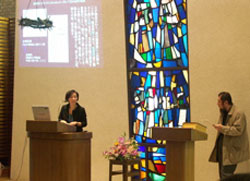Center for Interdisciplinary Study of Monotheistic Religions(CISMOR)Doshisha University
> Public Lectures > The Allegory of the Two Horns: Alexander the Great as a Sacred Figure in West AsiPublic Lectures
Lecture (Open for the public)
The Allegory of the Two Horns: Alexander the Great as a Sacred Figure in West Asi
| Date: |
2005/12/17 14:00-16:00 |
|---|---|
| Place: | Chapel in the Divinity Hall, Imadegawa Campus, Doshisha Univ. |
| Lecture: | Yuriko Yamanaka (National Museum of Ethnology) |
|
Literary accounts concerning Alexander the Great are known not only in the genres of history and tale, and what he symbolizes can vary significantly. Alexander is like 'the hero with a thousand faces,' and one of the faces has a close relationship to religion. This lecture by Yuriko Yamanaka discusses the link between the Alexander legend and the passage on Dhu ’l-qurnayn ('the two horned') in Sura 18 of the Qur’an. Ms. Yamanaka details the two horned’s revelation and focuses on 'Alexander the sacred' in Islam by way of examples: Ţabari 'tafsir', Tha`labi 'Qişaş al-anbiya al-musamma `ara’is al-majalis (The Collected Lives of the Prophets), and Nizami 'Iskandarnama (The Alexander Legend). Lastly, the speaker also pointed out the existence of the Dhu ’l-qurnayn legend, which was transmitted into Chinese and Japanese sources. In Islam, Alexander appears as "the two horned Alexander' (al-Iskandar Dhu ’l-qurnayn). This image results from the passage on 'the two horned' (Dhu ’l-qurnayn) in Sura 18:82-97 ('the Cave') of the Qur’an. This passage shows that Allah imparted to Muhammad what the latter answered 'everyone' when they asked him about the two horned. Yet because the identity of the two horned and why he was known by this name are not explained, these problems have been discussed for a long time. Today, Nöldeke’s opinion that this passage was dependent on Syriac Christianity’s tradition about Alexander may be considered the strongest. In Judaism and Christianity before the coming of Islam, Alexander had already acquired a certain sacred status. For the Jew he was regarded as the Messiah who brought the Kingdom of God from Heaven to earth, and for the Christian he was regarded as Jesus Christ's pioneer. Islam accepted such a sanctified Alexander as 'the two horned': as the defender of its religion, a propagator and a prophet. In Ţabari 'tafsir', many influences of the Jewish and Christian traditions are found. But, comparing 'tafsir' with these traditions, the former emphasized the role of god's apostle, contained no historical geographical description, and was more allegorical. Moreover, in Tha`labi 'Qişaş al-anbiya al-musamma `ara’is al-majalis,' which includes quotations from the historical writings, the life of Alexander from birth to death is consistently described and it contains an element of admonition. On the other hand, Nizami 'Iskandarnama' is constructed in three parts: in the first, Alexander is depicted as a conqueror with a role as missionary, in the second as a philosopher king, and in the third as a prophet, showing humanity’s limitations moralistically. In 'Iskandarnama,' based on various Alexander legends, Nizami drew Alexander as an Islamic hero. As regards Islam’s serious differences from the Jewish and Christian traditions, Islam was once the ruler of an area as large as that conquered by Alexander. Therefore, Alexander could become a real model for the caliph. In his legend a militant side is described, reminiscent of 'Jihad,' as well as a side depicting him as guardian the faithful community against aggressions by a foreign enemy. However, the ambition of Alexander the two horned was criticized in Islam, though it seems from the episode about his ascension to heaven that Islam was not as critical of him as the Christian theologians of Europe’s medieval age. The passage on 'Dhu ’l-qurnayn' in the Qur’an does not describe the historical context related to Alexander. Nevertheless, in religious literature after the Qur’an, in historical documents, and in other sacred writings, 'Dhu ’l-qurnayn' has always been inseparable from the historical Alexander. Ayumi Hosotani (CISMOR Research Assistant, Graduate Student, School of Theology, Doshisha University) |
|
|
Handout |
|

